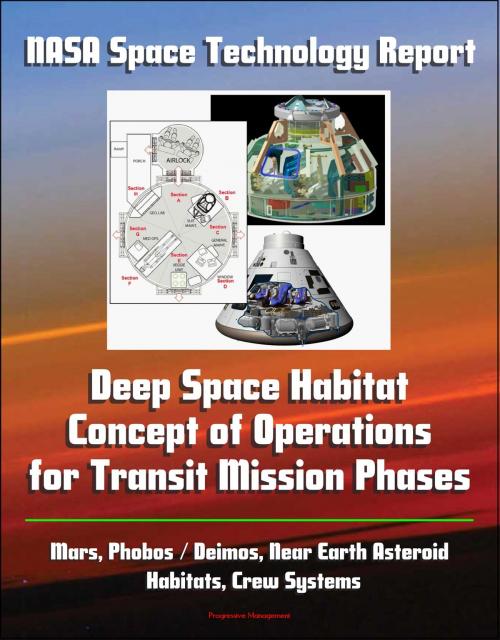NASA Space Technology Report: Deep Space Habitat Concept of Operations for Transit Mission Phases - Mars, Phobos / Deimos, Near Earth Asteroid, Habitats, Crew Systems
Nonfiction, Science & Nature, Technology, Aeronautics & Astronautics, Science, Physics, Astrophysics & Space Science| Author: | Progressive Management | ISBN: | 9781301127351 |
| Publisher: | Progressive Management | Publication: | August 10, 2013 |
| Imprint: | Smashwords Edition | Language: | English |
| Author: | Progressive Management |
| ISBN: | 9781301127351 |
| Publisher: | Progressive Management |
| Publication: | August 10, 2013 |
| Imprint: | Smashwords Edition |
| Language: | English |
This document describes a concept of operations (ConOps) for a habitat element to be used by human crews on future deep space missions; that is, missions well beyond the low Earth orbit of Space Shuttle and International Space Station missions of the past few decades. As one facet of a number of studies conducted by NASA's Human Spaceflight Architecture Team to better understand possible implementations of what the U.S. Human Spaceflight Plans Committee (also known as the Augustine Committee) has named the "flexible path," a workshop was conducted to consider how best to define and quantify "habitable volume" for these future deep space missions. One conclusion reached during this workshop was the need for a description of the scope and scale of these missions and the resulting capabilities needed for a Deep Space Habitat (DSH) element. A group of workshop attendees was established to prepare a ConOps document to address this need. The ConOps, as developed by this group, was structured to identify and capture nominal activities and functions that were likely to occur on the DSH for a range of design reference missions that encompass the currently envisioned flexible path. The group intended this ConOps to be used as an engineering/design tool to support more detailed systems engineering activities in the future, which provided guidance regarding the level of detail necessary for these descriptions.
Acronyms and Nomenclature * Section I - Introduction * Introduction * ConOps Major Assumptions * Document Scope * Other Applicable Documents * Section II - Destinations * Flexible Path Missions using a Deep Space Habitat * Near Earth Asteroid Missions * Mars Mission Characteristics * Phobos/Deimos Exploration Missions * Mars Surface Exploration Transit Mission * Summary of Destination Mission Characteristics * Section III - Habitat Functions and Activities * DSH ConOps Functions for Transit Mission Phases * Departure Activities * On-Board Piloting, Proximity Operations, & Navigation * Mission Specific Onboard Research * Crew Health/Medical Support * Crew Exercise * Off-Duty and Recreation * Food Preparation * Multipurpose Gathering Space * Crew Personal Accommodations * Crew Hygiene * General Housekeeping * Training * Crew Safe Haven * Support Systems * On-Board Subsystems Monitoring and Control * Docking Accommodations * Stowage * Maintenance, and Repair * Arrival Preparations * Daily/Weekly/Monthly Crew Time Allocations * Section IV - Analyses and Recommendations * What We've Learned * Uses of Study Results * Recommended Follow-on Work * Example Key DSH Questions * Section V - Appendices * Appendix A - NEA Medical Operations
This document describes a concept of operations (ConOps) for a habitat element to be used by human crews on future deep space missions; that is, missions well beyond the low Earth orbit of Space Shuttle and International Space Station missions of the past few decades. As one facet of a number of studies conducted by NASA's Human Spaceflight Architecture Team to better understand possible implementations of what the U.S. Human Spaceflight Plans Committee (also known as the Augustine Committee) has named the "flexible path," a workshop was conducted to consider how best to define and quantify "habitable volume" for these future deep space missions. One conclusion reached during this workshop was the need for a description of the scope and scale of these missions and the resulting capabilities needed for a Deep Space Habitat (DSH) element. A group of workshop attendees was established to prepare a ConOps document to address this need. The ConOps, as developed by this group, was structured to identify and capture nominal activities and functions that were likely to occur on the DSH for a range of design reference missions that encompass the currently envisioned flexible path. The group intended this ConOps to be used as an engineering/design tool to support more detailed systems engineering activities in the future, which provided guidance regarding the level of detail necessary for these descriptions.
Acronyms and Nomenclature * Section I - Introduction * Introduction * ConOps Major Assumptions * Document Scope * Other Applicable Documents * Section II - Destinations * Flexible Path Missions using a Deep Space Habitat * Near Earth Asteroid Missions * Mars Mission Characteristics * Phobos/Deimos Exploration Missions * Mars Surface Exploration Transit Mission * Summary of Destination Mission Characteristics * Section III - Habitat Functions and Activities * DSH ConOps Functions for Transit Mission Phases * Departure Activities * On-Board Piloting, Proximity Operations, & Navigation * Mission Specific Onboard Research * Crew Health/Medical Support * Crew Exercise * Off-Duty and Recreation * Food Preparation * Multipurpose Gathering Space * Crew Personal Accommodations * Crew Hygiene * General Housekeeping * Training * Crew Safe Haven * Support Systems * On-Board Subsystems Monitoring and Control * Docking Accommodations * Stowage * Maintenance, and Repair * Arrival Preparations * Daily/Weekly/Monthly Crew Time Allocations * Section IV - Analyses and Recommendations * What We've Learned * Uses of Study Results * Recommended Follow-on Work * Example Key DSH Questions * Section V - Appendices * Appendix A - NEA Medical Operations















